In the beginning, there was the percussion revolver, and it was good. But reloading those things took half a day, a picnic table, a pouch full of tools, and way too much patience, so we made sure to keep a good saber, knife, or hatchet nearby too. These also came in handy when we returned home to an angry wife, who was tired of cleaning the grease and blackpowder soot from our shirt and pants after a busy day on the battlefield.
Then God said, “Let there be the the self-contained, metallic cartridge,” and it was also good. Actually, it was gooder, because now we could reload without a sundial, animal fat, and a rag.
Making Peace
When Sam Colt decided to put the loading gate of the Single Action Army on the right side of the frame, it was probably in deference to the right-handed majority that would be using the revolver in combat, where reloads needed to be expeditious. If a shooter was going to be thumbing individual cartridges into the 1873, the first of the truly great cartridge revolvers, it made sense to do it with the more dexterous hand. For most shooters, that was going to be their right one.
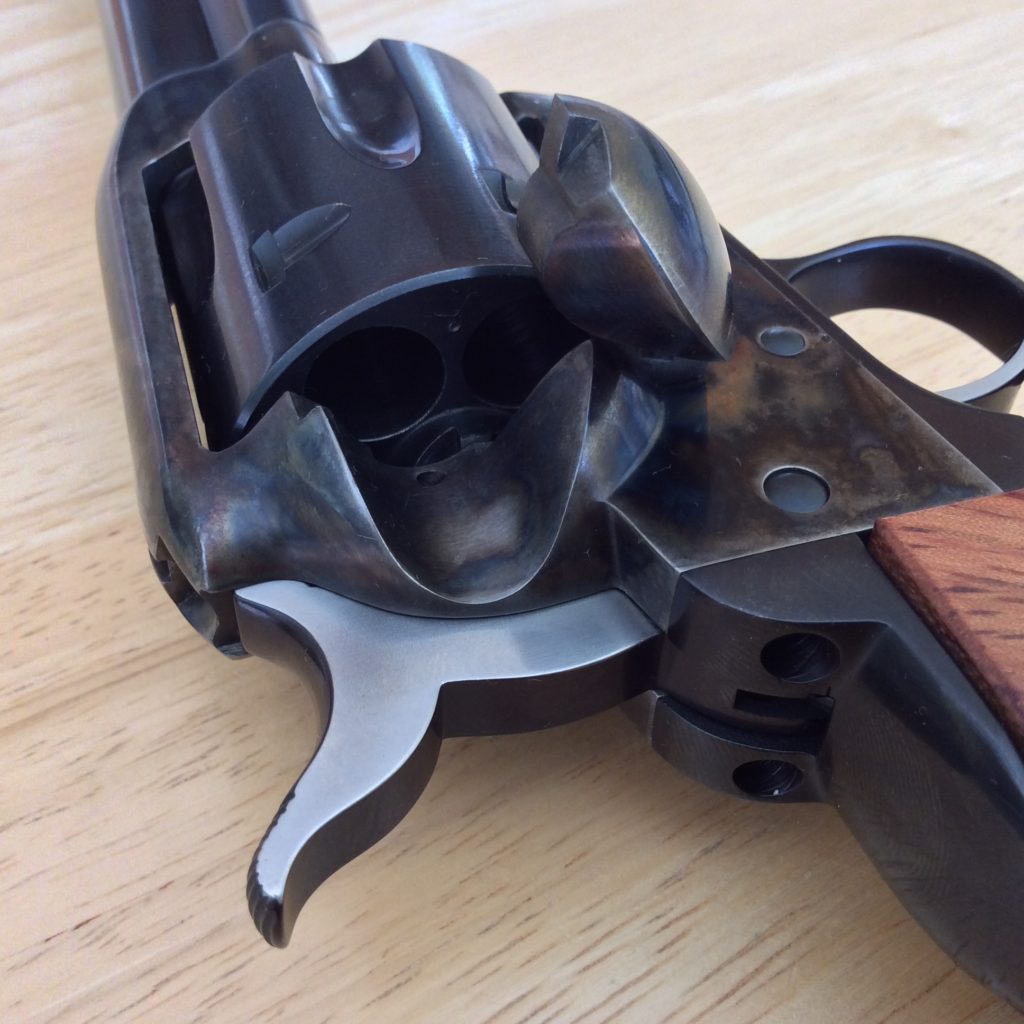
So, the gate went on the right, which allowed a shooter to cant the gun to the left, transfer it to the palm of their left hand, and open the gate with the right thumb. With a pushing motion, the cylinder could be rolled by the left thumb (with help from the middle finger, underneath) while the fingers of the left hand controlled the gun and steadied the cylinder, allowing the right hand to work the ejector rod. Once empty, the gun could be cradled muzzle down, so the right hand could accomplish the tricky part–feeding cartridges into the chambers without dropping them on the ground. This was easier said than done while on horseback, or while trying to make shaky hands work efficiently so you could avoid a scalping.
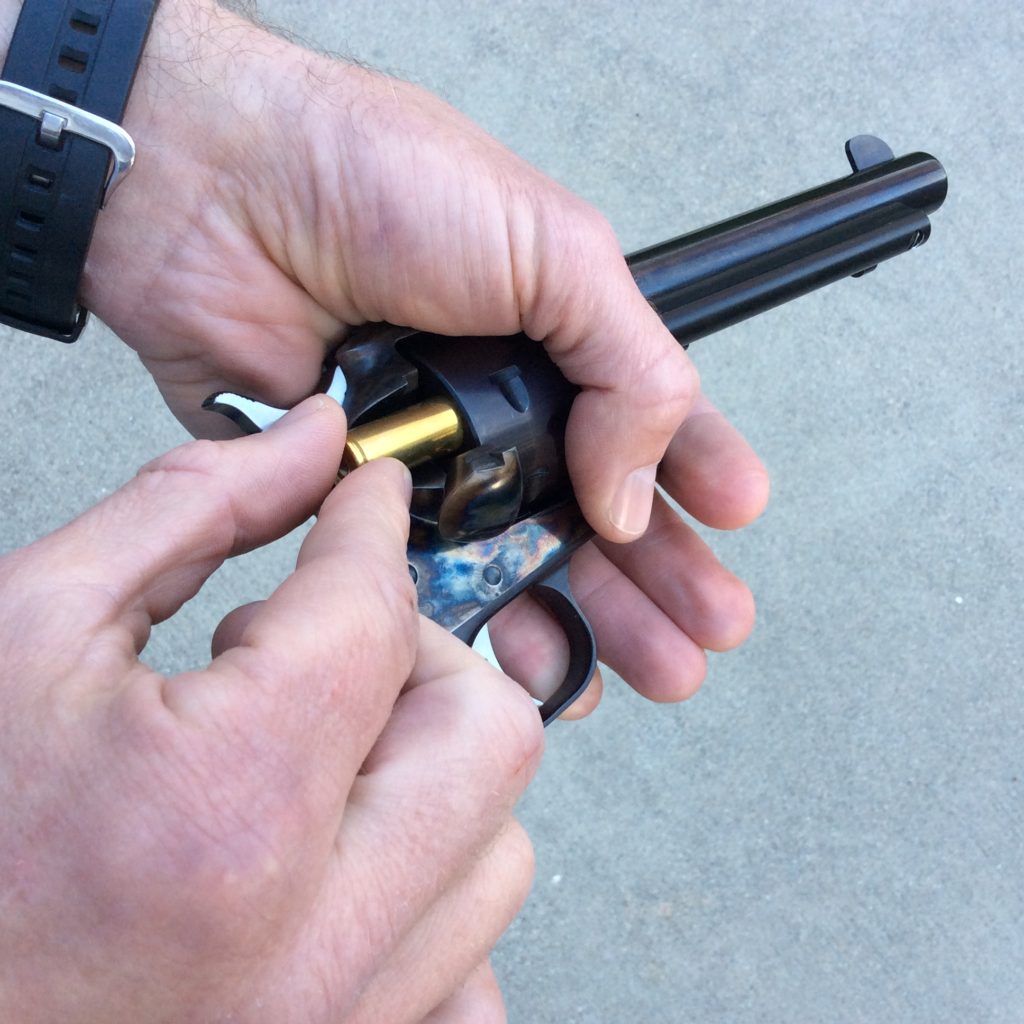
When all this was done, the gun had to be transferred back into the hand that was actually going to shoot it, and the “hand jive” was complete.
Had the Smith & Wesson Model 3 Schofield (with its break-top action that was released with the shooting hand thumb, and its automatic ejection–a wonderful design for a cavalryman!) been more popular and prolific, a pattern of keeping the gun in the shooting hand during reloading might have been established. However, it was not to be, and the vast majority of soldiers, cowboys, and plain folk wound up transferring their cartridge revolvers to their other hand when it was time to empty and reload, then putting them back into the shooting hand when it was time to make noise again.
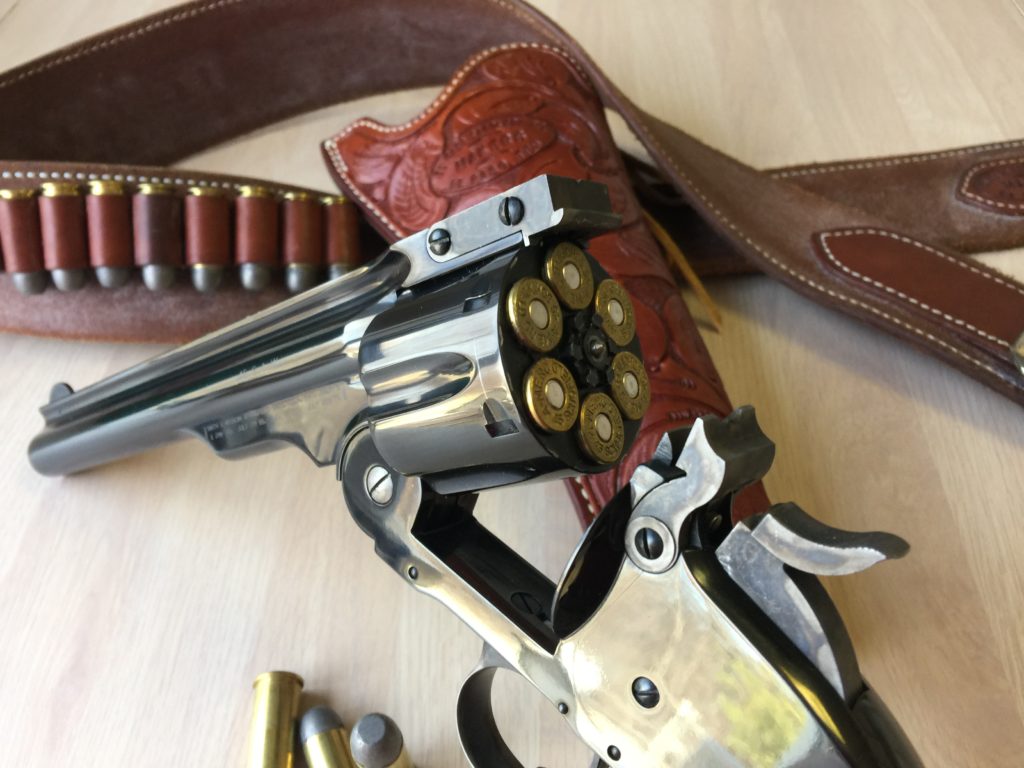
The New Century
That trend was not reversed with the coming of the swing-out cylinder designs from the likes of Horace Smith and Daniel B. Wesson, Samuel Colt, and others, just before the turn of the century. These guns all opened up to the left, and placed the cylinder latch at the left rear of the frame, where it could be easily operated with the right thumb (which was also the shooting hand thumb for most users–remember, we were still a long ways away from the popularization of two-handed holds, so you had a “shooting hand” and a “non-shooting hand” back then). Folks with long fingers might have been able to push the cylinder open with their trigger finger, but the majority of shooters used their left hand to pop it out, and the natural flow of things was for the left hand to assume control of the gun so the right could start feeding loose cartridges into the open chambers after they had been emptied.
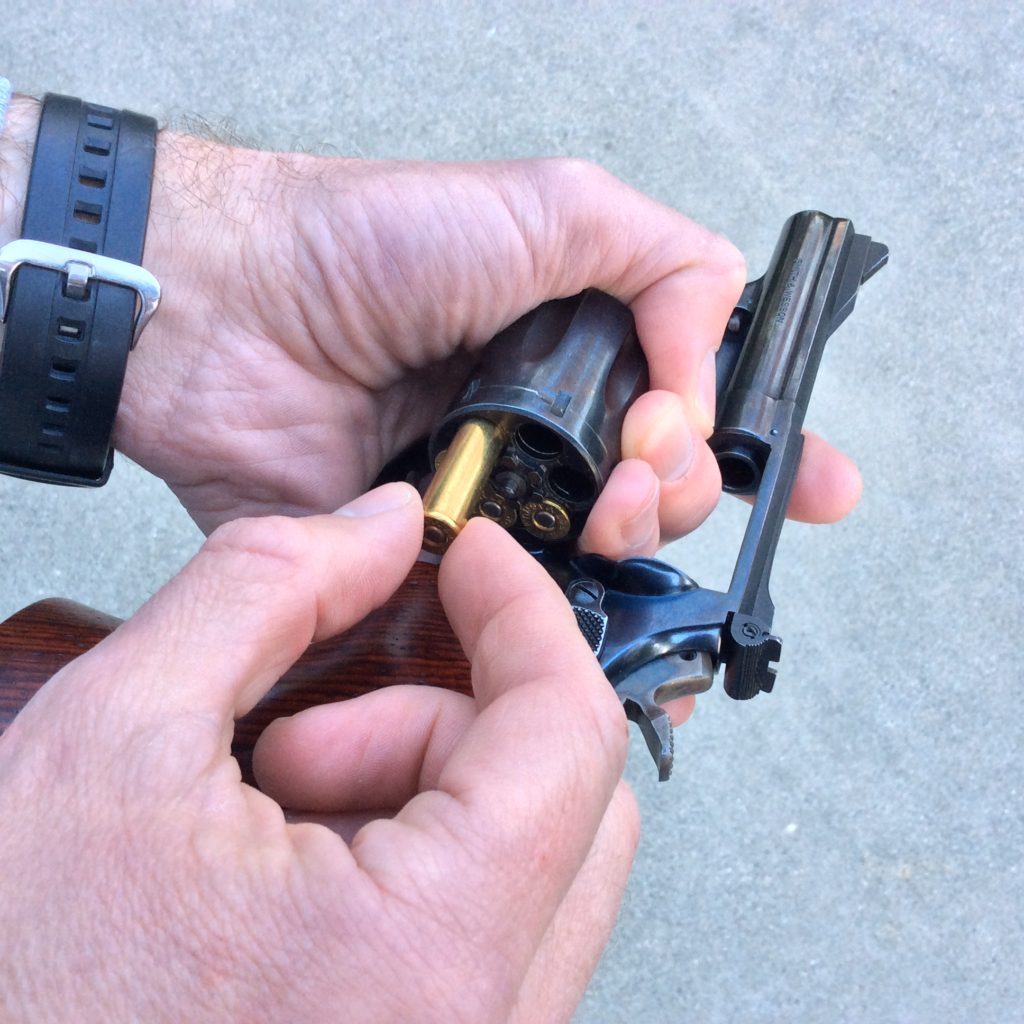 It was no different for the Southpaw minority. The swing-out cylinder guns were invariably transferred to the other hand to facilitate unloading and reloading, because there was no practical way to access the chambers if the gun was kept in the shooting hand.
It was no different for the Southpaw minority. The swing-out cylinder guns were invariably transferred to the other hand to facilitate unloading and reloading, because there was no practical way to access the chambers if the gun was kept in the shooting hand.
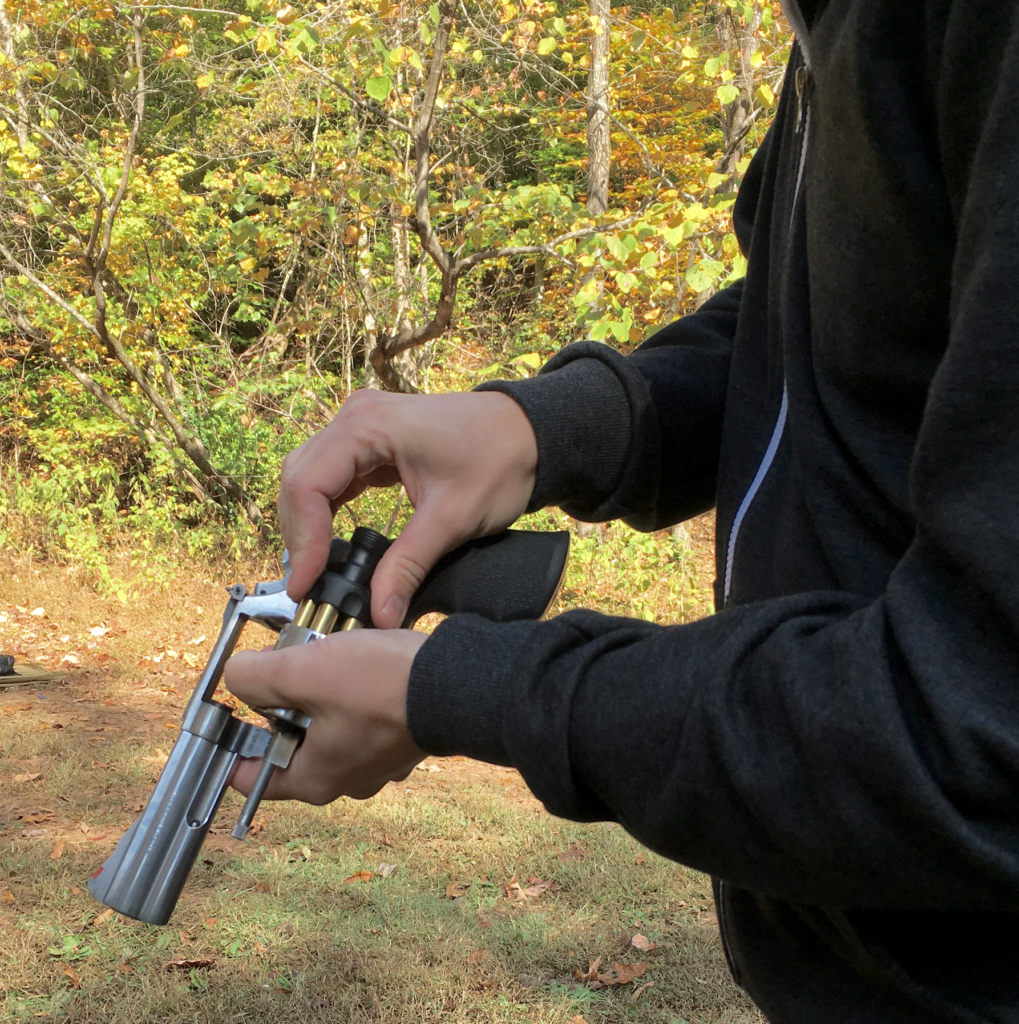
When practical speedloaders came of age in the 1960s and 1970s, there was a moment where all of this shuttling of the gun back and forth between hands could have changed. The best of the new loaders simplified the process and made it easier to get cartridges into the gun without spilling them, even if you used your less dexterous hand. If there was ever a chance that the concept of keeping the gun in the right hand and loading with the left hand would become popular, this was it. But the greater shooting community didn’t bite, and common sense prevailed. The more efficient and reliable habit of using the most nimble hand to thread the needle continued. Besides, most folks were still loading with loose cartridges anyhow. Even a lot of police officers stayed with loops right to the end.
New Wave and Wondernines
Then came the 1980s.
When America’s police and the shooting public fell hard for semiauto pistols in the era of parachute pants and dresses with big shoulder pads (ask your folks about it) they had to learn some new habits. On the self-chuckers, it made a lot more sense to keep the gun in the shooting hand, jettison the spent magazine with the conveniently located button (well, convenient for Righties, but the Wrongies were adaptable, and reversible/ambidextrous controls were on the horizon), and slap in a new magazine with the support hand. That’s the way God and John Browning (but I repeat myself) intended it to be.
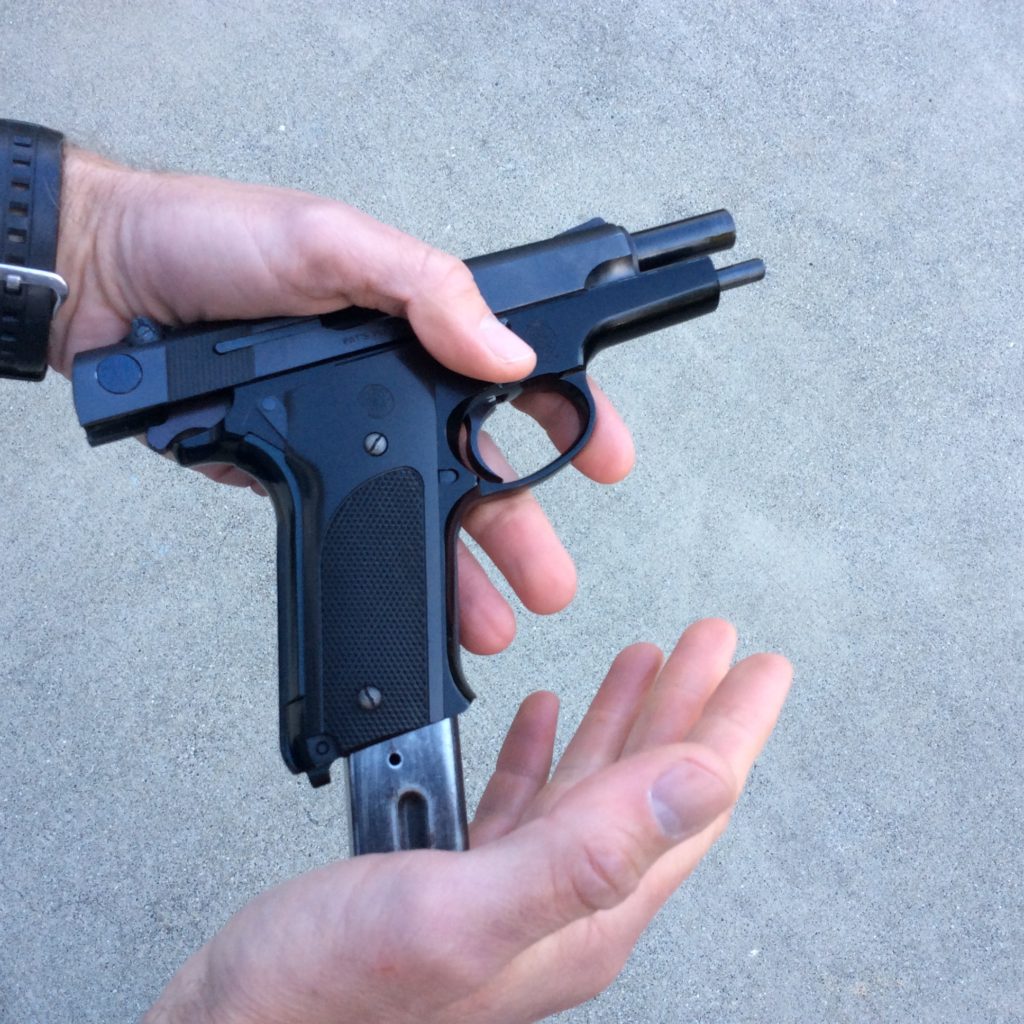
But there were diehards who refused to play ball. In fact, one of the funnier displays in police revolver-to-auto transition classes of the era was the reloading part. It wasn’t uncommon to see a right-handed shooter dump his mag after slide lock, then transfer the gun to the palm of his left, so that his right could feed the new magazine in (usually with an extra hammering motion). He’d been doing it that way with the round gun for years, and old habits die hard, you know.
Hand Jive 2.0
Fast forward to today, and we’ve exorcised those demons . . . kinda.
The autopistol has been the dominant arm in military, police, and private circles for so long in America that a new set of habits, built around the square gun, has become firmly entrenched. The autopistol doesn’t feel foreign in our hands, like it used to a few generations ago. We know how to run them efficiently, and we know that shuffling a gun back and forth unnecessarily during a reload is just a waste of time, right?
The funny thing is, within a generation or two, we managed to make the pistol, and its manual of arms, so familiar, that now we have folks out there who are uncomfortable working a revolver. We’re getting reports of young coppers who’ve confiscated revolvers from suspects but can’t figure out how to open and unload them, and have had to call a Sergeant to help them out!
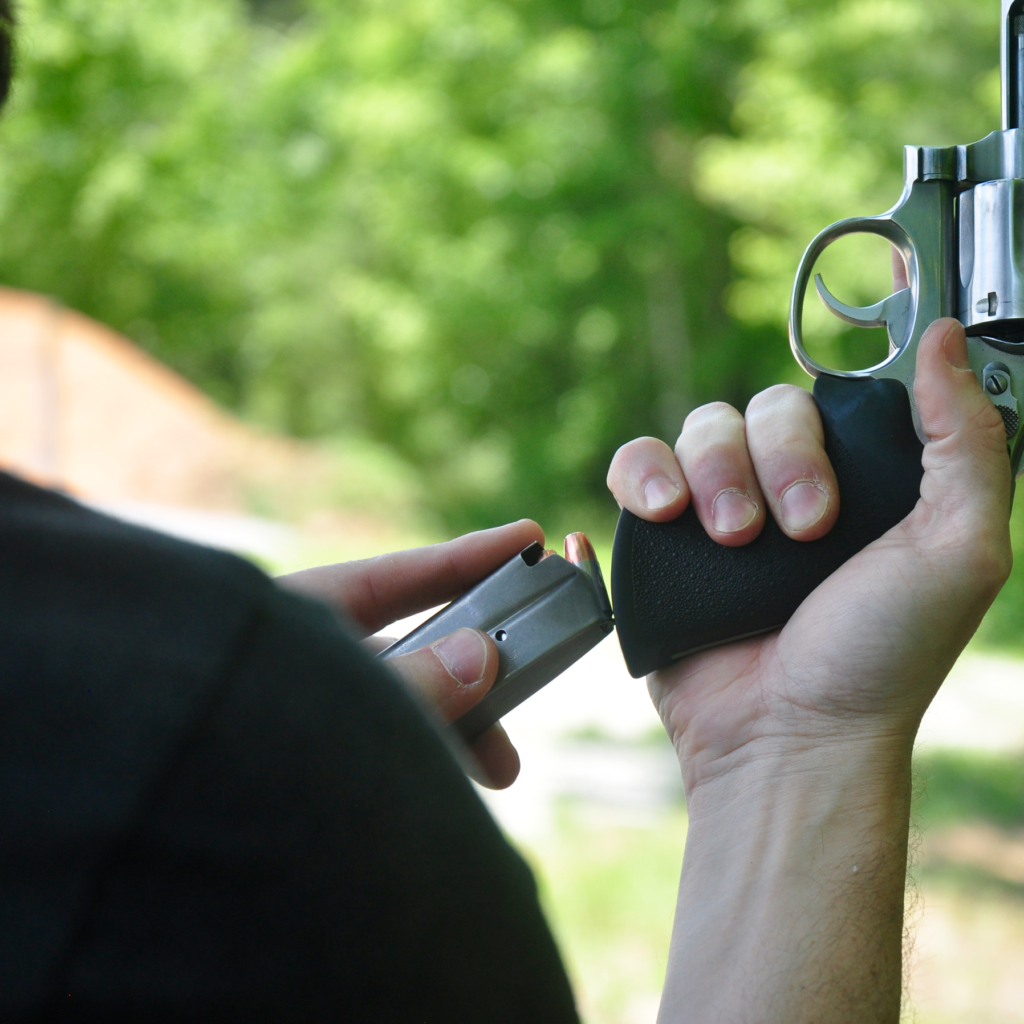
We’re also seeing a new twist on the hand jive. After being raised from the womb to keep the gun in the primary hand during reloads, some revolver newbies are trying to reload with their support hand, just as they do with their pistol. The wheel (gun) has come full circle.
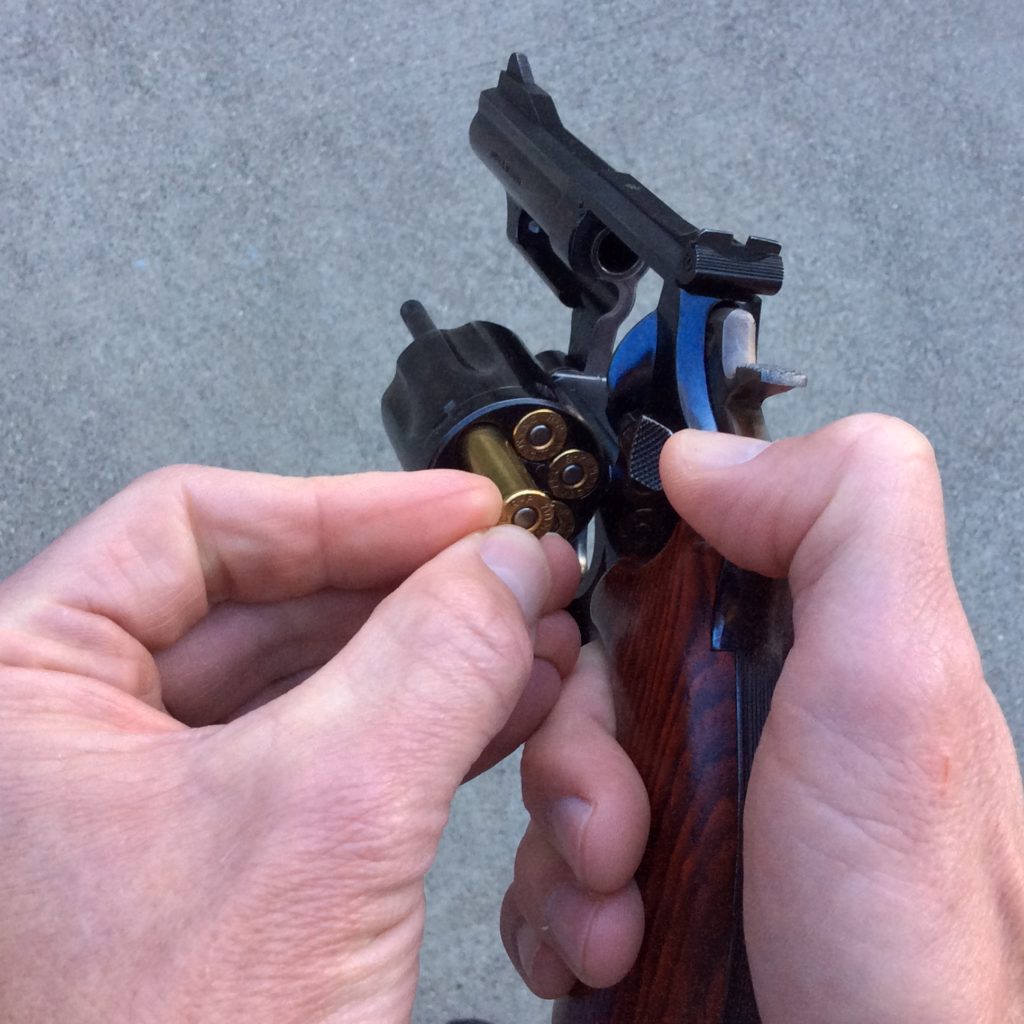
Are they wrong? I don’t know. I still happen to think it’s better to load the revolver with the more dexterous hand holding the cartridges, but there’s something to be said about not having to move the gun back and forth so much. In an era of extended thumbpieces, full moon clips and Jet Loaders, maybe we don’t have to worry so much about our “weak” hand not being up to the task? Maybe we can realize the advantage of keeping the gun in the shooting hand with a little extra training for the support hand?
Can you teach an old dog new tricks? I’m interested to know what you think. Let me hear from you in the comments, below. In the meantime, I’m off to change out the grip panels on my Glock, if I can just find the right screwdriver . . .
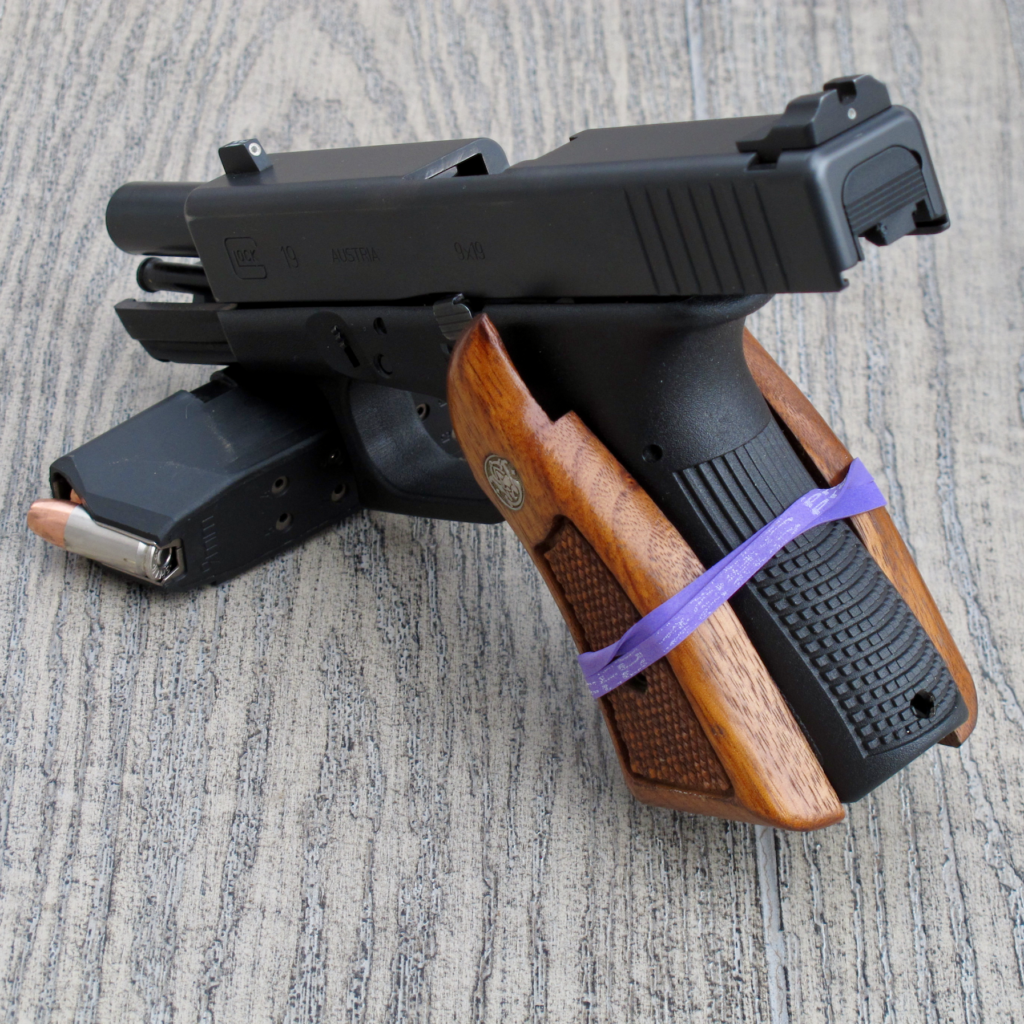

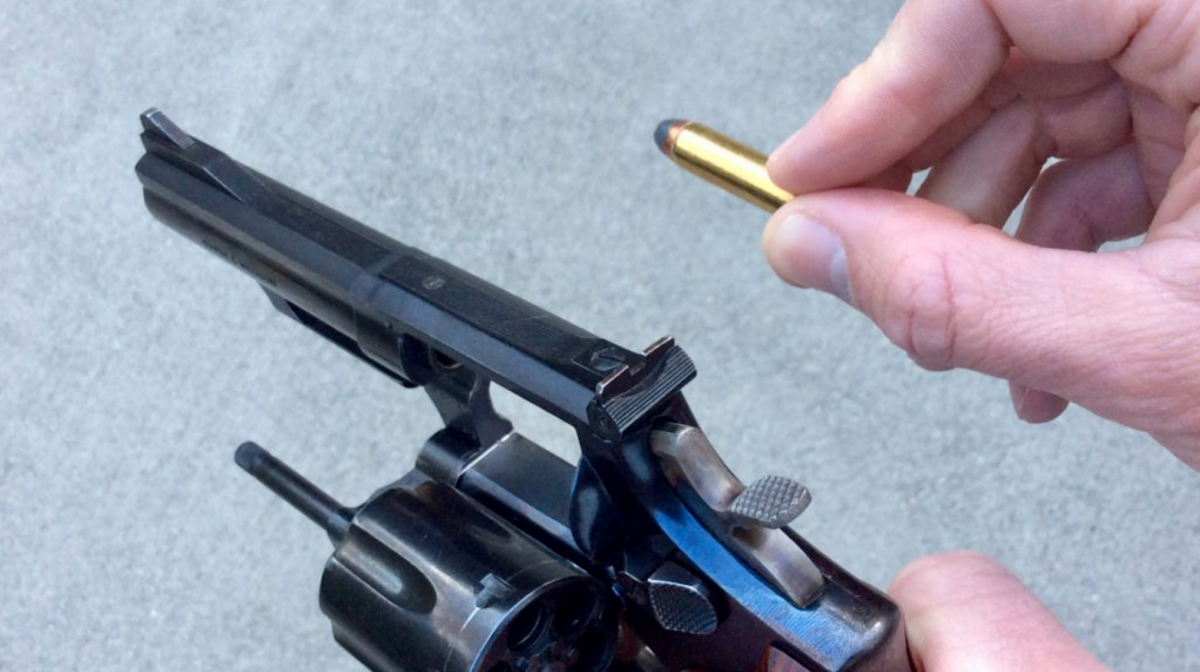
I tend to reload snubbies by not transferring hands:
http://shangrilatowers.blogspot.com/2010/12/guns-how-to-i-reload-revolver.html
For a larger revolver, a hand transfer might be better, because it’s harder to hold the cylinder open with the index finger of the right hand.
Interesting! Thank you Sir!
Left-handers are very able to adapt
so no hand firearm has really been a
problem. Neither have long guns.
Left-handers adapt to all
sort of societal ills.
Right-handers are just naturally
klutzy. They are to be pitied.
Of course, laughing at them is
perfectly OK too.
; ^ )
DeBethencourt (did I spell that right?) teaches a right hand hold reload that I imagine would work pretty well for a snubby. I don’t know if I should try to adopt it against ingrained habit though. And yes, you Southpaws can laugh at us, after all we are not in our right minds… but I’m told it’s not nice to make fun of mentally challenged folks.
Since I shoot left handed, I kind of have to transfer hands. I haven’t found a way to hold a revolver in a normal left handed shooting grasp without my hand being in the way of ejecting spent casings*. That said, I do like the De Bethencourt method of reloading if I am shooting right handed. That way, I can still get to my speed loaders effectively. If I was a right handed shooter, I don’t know if I would do things that way or not.
As has been mentioned elsewhere, I am a cross-dominate righty, so I guess both groups get to laugh at me.
* The obvious answer is to get a mirror-image revolver like those from Korth or Charter Arms. The problem is neither one of those meet my criteria (one is too expensive and one is too light; I think you can guess which is which), and I don’t know of any others.
Hmmm. Korth . . . Charter. Not usually mentioned together, eh? ; ^ )
Before speedloaders came along, we were taught that the weak hand holding the revolver cylinder formed a ‘cup’ so that when the phuque up pharie messed with your fumble finger reload from the drop boxes, you have a better chance of catching the round as opposed to losing it to the ground.
Ha! Oh, I’m well acquainted with that fairy . . . I keep it busy sometimes! ; ^ )
I remember the “cupping the cylinder” technique and even used it a time or two myself, but since I came of age after speedloaders had become mainstream, it never became part of my routine. Interestingly, my friend Mas Ayoob’s Stressfire reload actually incorporates a hold that could accomplish this to a certain degree.
I cut my teeth as a kid on Ruger single actions, and my grandfather’s M1917 S&W, which of course, used moon clips. No surprise my first couple of range days in our academy that phairy was busting a gut laughing at me. Silly me.
For a long time I had a ‘shrine’ to the Safariland Comp II. Still have more of those than I can count.
I load with my left, but I broke two right-hand fingers when a kid. In the weeks that followed, I learned to do so much with my left that I am almost ambidextrous to this day.
The photo with the caption
“Kids these days” is
absurd because obviously
the cartridges won’t fit
the gun.
Ha!
True, but the Glock grip panels add a whole new level of class to that gun. You don’t even have to ignore the purple rubber band.
My comment made way more sense in my mind. Sorry about that.
For the “kids these days” photo, I think the obvious issue is the term clip. There are revolvers that use (moon) clips, and that thing is a clip (TV told me so). Thus, they obviously go together.
Sooo many stories about revawvers and (semi)autos. One of my favorites re: the round gun and reloading:
In the era of having dump pouches (kids, look that up) I made the discovery of a neat little item called a ‘speed strip’, little pieces of plastic that held a half-dozen rounds in a straight line. Tried them, liked them, and put them in my dump pouches. During inspection, Sarge (one of the fun ones) saw the little tab from the speed strip poking up outside the pouch. Showed him one, he was intrigued, but said I couldn’t use them ‘because they weren’t issued’. For a while he didn’t know we compromised by my simply folding the tab under the flap of the dump pouch.
Then I discovered Speed Loaders, specifically Safariland’s first model. Tried them, liked them, and promptly added two of them to the belt. Sarge had a hissy fit, because A) ‘they weren’t issued’ and B) having 24 rounds on the belt simply wouldn’t do; we’re issued 12 and that’s all we were ‘allowed’ to have. Why, what would the Lieutenant say if he saw them?! Again, he didn’t know we compromised by my carrying those in the jacket pocket.
I don’t remember his reaction when we moved into the 20th century and switched over to semi-autos—-the S&W 645. But I do remember another Sarge–one of us ORF’s–offering to let a young pup shoot his old duty revawver. Handed the kid the gun and some ammo; the kid stood there with a befuddled look on his face. He didn’t know how to open and load it….. Ace
Ha! See? I wasn’t joking! I’ve actually run across some youngsters in uniform who didn’t know how to work ’em. Thanks for the backup, Ace.
Did Sarge ever find out about the backup gun that wasn’t issued either? ; ^ )
I know there are officers (and people in general) who don’t know how to open a revolver cylinder (I, too, have met them), but I have trouble understanding it. Other than the older Korths that had the cylinder release next to the hammer and maybe Dan Wessons (or the Taurus Raging series with two latches), I think it is painfully obvious how common revolvers are opened. I feel like these same people should have issues getting a door open or undoing their own pants.
Haha! Exactly! Well said, Sir!
Can’t open a revolver? That’s the same folks on the side of the road calling 911 for a flat tire, I guess. You’d think You Tube could show them how to fix that…
Actually, when looking back at Black Powder revolvers, loading all 6 chambers in less than one minute was not beyond possibility for an experienced Civil War soldier. At the time they became quite proficient at reloading the old percussion revolvers, as their life more often than not depended upon that ability in close quarters battle.
Well, we weren’t issued BUGs, but he wasn’t even slightly amused when he did a uniform inspection one shift, and insisted I remove my jacket so he could see the whole shirt—and discovered I had a BUG in a shoulder holster. He didn’t mind BUGs, but thought a 6″ S&W Model 25 was a bit much…..
I did enjoy messing with him. Ace
; ^ )
As a shooter who is left-handed but right eye-dominant, I have never had a problem holding a revolver in my right hand and loading (singly, speed loader, or strip) from the left. Best of both worlds!
Chas, do you shoot with your left hand, primarily, then transfer to the right for loading?
Mike,
I know this is a revolver site but I was just curious if that S&W 459 pictured was yours? When it comes to semi world Smith autoloaders are some of my favorites along with the ol 1911. However I have noticed the “kids these days” don’t share my appreciation for old Smith DA/SA autos.
Anyway Mr. Wood thanks for another well written and enjoyable article.
I meant to say model 59 not 459.
Martin, I’m glad you liked the photo and article. I don’t mean to disappoint, but the S&W autos were never a favorite of mine. The 39 certainly feels good in the hand and has a charm to it (much more handsome than a 59, I think) but they were finicky. I didn’t trust the S&W autos much until the Third Gen series (4 digits) came along, and by that time I had discovered the Sig P226 and was dedicated to it, so I didn’t pay much attention to them. I never liked the slide-mounted safety of the S&Ws, and would feel more at home with your 1911s! I hope that isn’t a deal breaker and you’ll keep reading RevolverGuy! ; ^ )
Martin,
I’m with you – I’m a big fan of the traditional, metal S&W DA/SA autos, though I also agree with Mike and prefer the 4-digit models. Every one I’ve shot is accurate and runs, as my dad would say, like a Singer sewing machine. It’s a shame those got discontinued, but S&W isn’t doing too shabby with the M&P line nowadays, either (and they’re listening to the market, too – wish the same could be said for their revolver line, but I digress).
Justin
Justin,
I agree with both you and Mike that the 3rd gen Smith autos were improved and the 5906 may be the toughest 9mm ever buillt. Still to me they lacked the charm of the old blued 39 and its wood grips. It’s funny when I first joined the military in the 90’s (I know I’m dating myself here) I fell in love with the M9 and the Smith 5904. Back then autopistol reliability was not what it is today but these pistols were reliable. My way of thinking back then was these two pistols, along with the Sig, were the best duty pistols ever built. At that time I believed revolvers were for the most part obsolete. Now I see these “kids” with their Glocks looking at my ancient metal DA/SA autos the same way I used to look at revolvers. Needless to say as I got older I learned to appreciate the revolvers simplicity, reliability and rich history. Maybe someday these old warrior pistols will be appreciated again.
The 39 is handsome, and I think the grip was better than any of the “classic” S&W autos that came after it.
I started my service with the Model 15 and we got the M9s later. Just between you and me . . . the M9 was better . . . but don’t tell anybody I said that.
Model 15 Flashback Alert.
I remember as a kid, old man was in SAC, so I spent a good bit of time ‘hanging out’ on used to be McCoy AFB. I remember all of the APs had (what I learned later on were) S&W Model 15 revolvers in cross draws. To an elementary school kid, those guys looked meaner than any of the cops and deputies in town. : )
What a GREAT memory! When I read it, I had visions in my head of gleaming helmets and starched greens with creases so sharp you could cut a finger on them — or perfectly-tailored, inspection-ready, blues, with ascots and those new berets that General LeMay introduced — with the distinctive arm band of the APs/SPs.
I should state for the record that the Model 15 is one of my all-time favorite guns, but the Air Force inventory was in pretty rough shape by the time I entered. Parkerizing them, as Uncle Sam did, was a sin that I still haven’t forgiven!
The M9 was a better gun for combat though. The Air Force’s .38 Spl ammo was pretty awful for anything other than drilling long, straight, holes. The 9mm ball wasn’t much better, but you had almost 3X on board, and we aircrews were usually issued 115 JHP, which was helpful. Hit potential with the M9 was much better.
Still, I’ll always reserve a special place in my heart for the Combat Masterpiece!
Y’all are bringing back some memories. I finished my military career in the Army but started it in the Air Force as an SP! I still remember that blue beret but can’t say I was very fond of it. By the time I came along the 15 had long been replaced but I still remember the flight sergeant talking about it rather affectionately. As I mentioned before at that time revolvers just didn’t impress me and I remember thinking how much better equipped we were with our mighty M9. If I had only knew then how much my thinking would change. Today, despite owning numerous autos, the gun I keep on my nightstand is a Gp100.
That pic of the Glock with the S&W wood grips is priceless! So true about new officers having no idea how to handle (or unload) a revolver. I’ve seen it happen! Great article Mike! “God and John Browning (but I repeat myself)….” Ha!
I may have to write up my MAS 1892 8mm…the cylinder opens to the right!
That’s the only thing in France that leans Right, then. ; ^ )
I’d love to see that article from you, buddy!
I am left handed but right eye dominant. So I shoot better right handed. I am comfortable shooting either hand. But I continue to struggle with reloading with the cylinder rolled out to the left and trying to reload using my left hand. I have tried individual rounds and speed loaders. I have no issue with using my right thumb to release the cylinder.
So, for you David, it works better to do the reload like a right hander traditionally would, with the gun held in the left hand and the right doing the loading?
Nah, no deal breaker. Some people like Chevy and some people like Ford, however the people who like Chevy are wrong! Jk.
The finicky aspect of the old 59 and 459 was at least somewhat due to poor magazines. Putting a new Mec-Gar mag in a 59 can often fix it’s problems. Still the Sig 226 is a quality piece and a good choice. Too many times people get in arguments over which auto is the best when the fact is it is a personal choice. I am curious, since you are retired military, about your opinion of the Beretta M9.
Whew! Glad my truck is an ’89 F-150 then! ; ^ )
Yes, the mags were definitely a weakness in the early guns. S&W made a few variants trying to fix that issue. Your recommendation for Mec-Gars is excellent.
You’re absolutely right Martin. Variety is the spice of life, and my opinion matters not a whit. We all have different likes and dislikes, and there’s no right or wrong to it. Heck, there’s people out there who . . . gulp . . . don’t like revolvers–we will pray for their salvation, though!
; ^ )
I’m probably going to upset more folks saying this (apologies!), but you asked . . .
The M9 wasn’t my favorite either. On the plus side, the pistol was very accurate, the capacity was good, and the triggers were pretty good for the era. But the gun was much too large for the caliber, which made it problematic as a general-issue gun that had to fit the masses. It fit my large hand well, but I saw too many troops struggle with it, particularly in DA mode. Ironically, the 1911 fit smaller hands better and was more proportionate for its cartridge.
Like the S&Ws, I didn’t like the slide-mounted safety/decocker (I always wished they had selected the “G” model instead). The locking block was a weakness (I saw quite a few broken ones) that handicapped an otherwise reliable pistol. They definitely liked to be run wet, which was problematic in the desert (especially with those crappy Checkmate magazines). I didn’t care for the sights, either.
Is it a bad pistol? Heavens no. Like the S&W autos, it’s just not my favorite. I don’t mean to say any of these were bad guns, they just weren’t my preference. If I had to carry one of these on duty (and I did), I’d be just fine. In the end, it’s more about the Indian than the Arrow, eh?
“In the end, it’s more about the Indian than the Arrow, eh?” So true. Technology and and a magazine with unlimited rounds won’t help you if you don’t have the guts and will to win.
Maybe I just married a woman far smarter than the folks described, but when I taught her to shoot a handgun, she got it right away.
I began by handing her an empty revolver and I asked her to close the cylinder. Then I kept my mouth shut. She activated the cylinder release, popped it open, closed it again, and was ready for the lessons on stance and grip. She never had shot any gun before but had all the safety rules down by intuition except she liked to keep her finger on the trigger.
She got out of that habit and outshoots me now at the range.
She’s a keeper!
I keep the gun in my right hand unless I am loading with loose ammo. Speedloaders and speed strips the gun doesn’t move.
https://www.youtube.com/watch?v=DH5yS3XTeg0
https://www.youtube.com/watch?v=dH64mGXDhIU
Thanks Nate! Good to hear from you. Nice work in the videos!
I hand my empty revolver to my faithful Gun Bearer, and he reloads, after handing me a freshly-recharged one…that is, if he hasn’t retreated at high speed! Most inconvenient!
Nothing compares to video…SLOW MOTION VIDEO of the different methods to reload a DA revolver.
For me, a right handed person, when all is said and done I think Massad Ayoob’s “stress reload” is the most sensible.
To summarize:
Finish firing, unlatch cylinder with right hand while pushing forward and strike the ejector with left hand with revolver facing upward, then grab the open cylinder and frame with your left hand holding it open and preventing the cylinder from rotating. Invert the revolver so the butt is now against your belly. Meanwhile you should be picking your speed loader with your right hand and it should now insert loader into the cylinder. Close the revolver with both hands like a book and re-assume normal grip letting the speedloader fall.
The advantages here are subtle, but important. You use the hand to strike the ejector smartly and it is struck squarely, preventing bending of the rod or weak ejection. You wont be forced to put your fingers near any potentially hot part of the revolver (the forcing cone area). You are using your high dexterity hand for high dexterity tasks. And since the revolver butt is against your body you can actually position the speedloader without the use of your eyes, so it can be done in the dark or when you want to look around. I’ve also found that if you are holding a flashlight in your left hand, you can pretty much do all this stuff with a small flashlight in your hand and you don’t need to pocket it or drop it. This alone argues STRONGLY against any weak-hand reloading method…
I’ve tried both Safariland and HKS speedloaders. I honestly don’t have a preference. The Safariland ones may be nominally faster, but at least the COMPI, which is the practical one for carry, requires you to push the body of the loader not the plunger on the back. With the HKS you must twist it and once you get that motion down it’s pretty easy as long as you use a method, like the stress reload, which holds the cylinder securely. I’ve been wanting to get my hands on a S.L.Variant, but it has proven elusive.
Anthony, if you go backwards in the blog, you’ll see an entire article on the Stressfire Reload. Hopefully you’ll find some other articles to enjoy too, along the way.
I’m looking for it. And this was a very funny post. Love the mag being inserted in the grip.
Oddly you’re assuming too much though. My wife was born in 1988 and no matter what I do she will ask me how to operate any semi auto prior to attempting use. To be fair she’s been forced to use so many. Her father with 1911s. Me with my H&KP7. Her brother with his Kahr. It all confused her. Nobody seems to agree yet upon the best system with autos, while it has been settled for a century with revolvers (excepting some bizzare Italian ones).
I think Mike was referring to professionals, among whom nearly everyone is in agreement on the basic mechanics of reloading autoloaders.